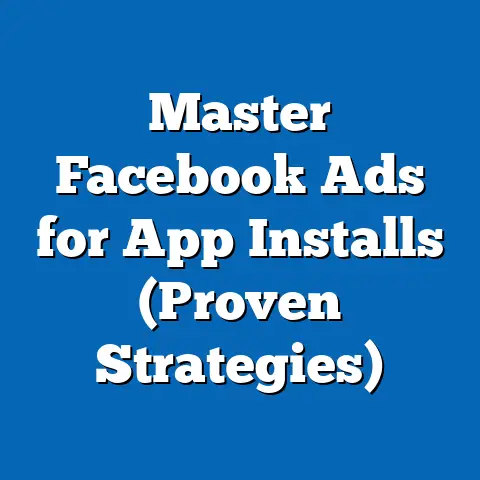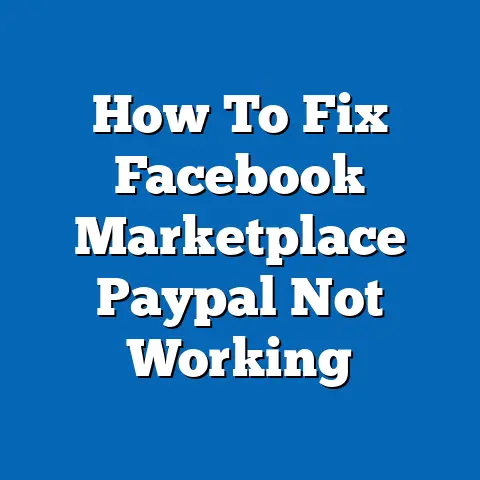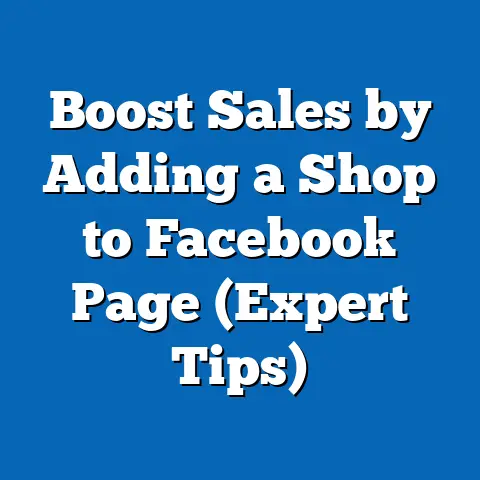Creating a New Facebook Ad Account (Expert Step-by-Step Guide)
In today’s fast-paced digital world, advertising is no longer confined to traditional mediums. Facebook, despite the emergence of newer social platforms, remains a dominant force in the advertising landscape. With its massive user base and sophisticated targeting capabilities, Facebook offers unparalleled opportunities for businesses to connect with their ideal customers. Having a well-structured Facebook ad account is paramount for any business aiming to leverage this platform effectively. In this guide, I’ll walk you through the process of creating a new Facebook ad account, ensuring you’re set up for success from the get-go. I’ll share my insights and experiences to help you navigate the process smoothly.
Understanding the Importance of a Facebook Ad Account
A Facebook ad account isn’t just a place to throw money at ads; it’s the central hub for your online marketing strategy on the platform. Think of it as the command center for all your advertising activities. Without a properly set up account, you’re essentially flying blind, unable to track your performance or optimize your campaigns effectively.
The Role of a Facebook Ad Account in Online Marketing Strategies
In the grand scheme of online marketing, a Facebook ad account plays a critical role in driving traffic, generating leads, and boosting sales. It allows you to tap into Facebook’s extensive network of users, targeting specific demographics, interests, and behaviors. This precision targeting ensures that your ads are seen by the people most likely to be interested in your products or services.
I’ve seen firsthand how a well-executed Facebook advertising strategy can transform a business. One of my clients, a small local bakery, struggled to attract new customers. By setting up a targeted Facebook ad campaign, we were able to reach people in their area who were interested in baked goods. Within weeks, they saw a significant increase in foot traffic and online orders.
Benefits of Advertising on Facebook
Advertising on Facebook offers a plethora of benefits, including:
- Reaching a Diverse Audience: Facebook boasts billions of active users worldwide, providing access to a diverse range of potential customers.
- Advanced Analytics: Facebook’s robust analytics tools allow you to track the performance of your ads in real-time, providing valuable insights into what’s working and what’s not.
- Cost-Effectiveness: Compared to traditional advertising methods, Facebook ads can be incredibly cost-effective, especially when you optimize your campaigns effectively.
Types of Facebook Ads
Facebook offers a variety of ad formats to suit different marketing objectives. Here are a few examples:
- Image Ads: Simple and effective, image ads are great for showcasing your products or services.
- Video Ads: Engaging and attention-grabbing, video ads are ideal for telling your brand story.
- Carousel Ads: Allowing you to display multiple images or videos in a single ad, carousel ads are perfect for showcasing a range of products.
- Lead Ads: Designed to capture leads directly on the Facebook platform, lead ads make it easy for potential customers to provide their contact information.
These different ad types can cater to various marketing objectives, whether you’re aiming to increase brand awareness, generate leads, or drive conversions.
Takeaway: A Facebook ad account is essential for online marketing success, offering access to a vast audience, advanced analytics, and cost-effective advertising options.
Preparing to Create Your Facebook Ad Account
Before diving into the technical aspects of creating a Facebook ad account, it’s crucial to lay the groundwork by defining your advertising goals, identifying your target audience, and establishing a budget. This preparation will ensure that your ad account is set up strategically from the start.
Prerequisites for Creating a Facebook Ad Account
To create a Facebook ad account, you’ll need:
- A Personal Facebook Profile: Facebook requires you to have a personal profile to create and manage an ad account.
- A Facebook Business Page: Your business page will be linked to your ad account, allowing you to run ads on behalf of your business.
It’s important to note that while you need a personal profile, your personal information won’t be visible in your ads. Facebook keeps your personal and business activities separate.
Defining Your Advertising Goals and Target Audience
Before you start creating ads, take the time to define your advertising goals. What do you want to achieve with your Facebook ads? Are you looking to increase brand awareness, generate leads, or drive sales?
Once you’ve defined your goals, identify your target audience. Who are you trying to reach with your ads? Consider factors such as age, gender, location, interests, and behaviors.
I’ve found that creating detailed buyer personas can be incredibly helpful in defining your target audience. A buyer persona is a fictional representation of your ideal customer, based on research and data about your existing customers.
Establishing a Budget
Having a clear budget is essential for managing your advertising spend effectively. How much are you willing to spend on Facebook ads? Consider your overall marketing budget and allocate a portion specifically for Facebook advertising.
It’s also important to understand the different bidding options available on Facebook. You can choose to bid manually or let Facebook optimize your bids automatically. Experiment with different bidding strategies to see what works best for your business.
Takeaway: Prepare for success by defining your advertising goals, identifying your target audience, and establishing a budget before creating your Facebook ad account.
Step-by-Step Guide to Creating Your Facebook Ad Account
Now that you’ve laid the groundwork, it’s time to create your Facebook ad account. Follow these step-by-step instructions to get started:
1. Signing In to Facebook
Start by logging into your personal Facebook account. As I mentioned earlier, you’ll need a personal profile to create and manage an ad account.
It’s important to use a business-related account for advertising purposes. This will help you keep your personal and business activities separate.
2. Accessing Facebook Business Manager
Facebook Business Manager is a tool that allows you to manage your ad accounts, pages, and other business assets in one place. It’s essential for anyone serious about advertising on Facebook.
To access Business Manager, visit business.facebook.com.
3. Creating Your Business Manager Account
If you don’t already have a Business Manager account, you’ll need to create one. Follow these steps:
- Click the “Create Account” button.
- Enter your business name, your name, and your business email address.
- Follow the prompts to provide additional information about your business.
- Verify your email address by clicking the link in the email you receive from Facebook.
4. Setting Up Your Ad Account
Once you’ve created your Business Manager account, you can set up your ad account. Here’s how:
- In Business Manager, navigate to “Business Settings.”
- Click “Ad Accounts” in the left-hand menu.
- Click the “Add” button and select “Create a new ad account.”
- Enter your ad account name, time zone, and currency.
- Choose the business that the ad account will be used for.
5. Configuring Payment Information
Next, you’ll need to set up your payment method. Here’s how:
- In Business Manager, navigate to “Business Settings.”
- Click “Ad Accounts” in the left-hand menu.
- Select your ad account.
- Click “View Payment Methods.”
- Click “Add Payment Method.”
- Enter your credit card or PayPal information.
You can manage your payment methods and view your billing history in the “Billing” section of Business Manager.
6. Adding Team Members (if applicable)
If you’re working with a team, you can add team members to your ad account and assign them different roles. Here’s how:
- In Business Manager, navigate to “Business Settings.”
- Click “Users” in the left-hand menu.
- Click “Add People.”
- Enter the email addresses of the people you want to add.
- Choose the role you want to assign to each person (e.g., admin, advertiser, analyst).
Each role has different permissions, so choose the role that’s most appropriate for each team member.
Takeaway: Follow these step-by-step instructions to create your Facebook ad account and configure your payment information.
Navigating the Facebook Ads Manager Interface
Now that you’ve created your Facebook ad account, it’s time to familiarize yourself with the Ads Manager interface. This is where you’ll create and manage your ad campaigns.
Overview of the Ads Manager Dashboard
- Campaigns: Campaigns are the top-level organizational structure for your ads. Each campaign has a specific objective, such as increasing brand awareness or driving conversions.
- Ad Sets: Ad sets are groups of ads that share the same targeting, budget, and schedule. You can use ad sets to test different targeting options and optimize your campaigns.
- Ads: Ads are the individual creatives that you show to your target audience. Each ad includes a headline, description, image or video, and call to action.
Essential Metrics to Monitor
To track the performance of your ads, it’s important to monitor key metrics such as:
- Reach: The number of people who saw your ad.
- Impressions: The number of times your ad was displayed.
- Click-Through Rate (CTR): The percentage of people who clicked on your ad after seeing it.
- Cost Per Click (CPC): The average cost you paid for each click on your ad.
- Conversion Rate: The percentage of people who took a desired action after clicking on your ad, such as making a purchase or filling out a form.
By monitoring these metrics, you can identify areas for improvement and optimize your campaigns for better results.
Familiarity with the Interface
The more familiar you are with the Ads Manager interface, the more efficiently you’ll be able to manage your ad campaigns. Take the time to explore the different features and settings available in Ads Manager.
Takeaway: Familiarize yourself with the Ads Manager interface to efficiently create and manage your ad campaigns.
Best Practices for Managing Your Facebook Ad Account
Creating a Facebook ad account is just the first step. To achieve long-term success, it’s essential to manage your account effectively. Here are some best practices to follow:
Organizing Campaigns and Ad Sets
Organize your campaigns and ad sets logically to make it easier to track your performance and optimize your campaigns. Use clear and descriptive names for your campaigns and ad sets.
I recommend structuring your campaigns based on your marketing objectives. For example, you might have one campaign for brand awareness, one for lead generation, and one for conversions.
Regular Performance Analysis and Optimization
Regularly analyze the performance of your ads and make adjustments as needed. Use the insights you gain from your analytics to optimize your campaigns for better results.
A/B testing is a great way to test different ad creatives, targeting options, and bidding strategies. By testing different variations, you can identify what works best for your business.
Audience Segmentation and Retargeting
Segment your audience based on demographics, interests, and behaviors. This will allow you to create more targeted ads that resonate with specific groups of people.
Retargeting is a powerful technique that allows you to show ads to people who have previously interacted with your business, such as visiting your website or liking your Facebook page. Retargeting can be incredibly effective in driving conversions.
Takeaway: Manage your Facebook ad account effectively by organizing your campaigns and ad sets, regularly analyzing your performance, and using audience segmentation and retargeting.
Conclusion
Creating a Facebook ad account is a crucial step for any business looking to leverage the power of social media advertising. By following the steps outlined in this guide, you can set up your account correctly and start running effective ad campaigns. Remember to define your advertising goals, identify your target audience, and establish a budget before you begin. And once your account is set up, be sure to manage it effectively by organizing your campaigns, analyzing your performance, and using audience segmentation and retargeting.
A well-set-up Facebook ad account can significantly enhance your business’s online marketing efforts and foster long-term success. So, take the time to set up your account properly and start reaping the rewards of Facebook advertising. Good luck!






